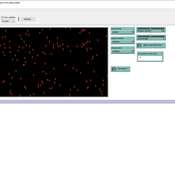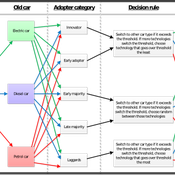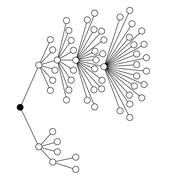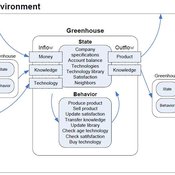Julia Kasmire
Affiliations Personal homepagehttps://sites.google.com/view/drjkasmireresearch/home
Professional homepagehttps://www.research.manchester.ac.uk/portal/julia.kasmire.html
ORCID more infohttps://orcid.org/0000-0003-2684-6330
GitHub more info
About me
Name: Dr. Julia Kasmire
Position: Post-doctoral Research Fellow
Where: UK Data Services and Cathie Marsh Institute at the University of Manchester.
Short Bio
2004 - BA in Linguistics from the University of California in Santa Cruz, including college honours, departmental honours and one year of study at the University of Barcelona.
2008 - MSc in the Evolution of Language and Cognition from the University of Edinburgh, with a thesis on the effects of various common simulated population features used when modelling language learning agents.
2015 - PhD from Faculty of Technology, Policy and Management at the Delft University of Technology under the supervision of Prof. dr. ig. Margot Wijnen, Prof. dr. ig. Gerard P.J. Dijkema, and Dr. ig. Igor Nikolic. My PhD thesis and propositions can be found online, as are my publications and PhD research projects (most of which addressed how to study transitions to sustainability in the Dutch horticultural sector from a computational social science and complex adaptive systems perspective).
Additional Resources
Many of the NetLogo models I that built or used can be found here on my CoMSES/OpenABM pages.
My ResearchGate profile and my Academia.org profile provide additional context and outputs of my work, including some data sets, analytical resources and research skills endorsements.
My LinkedIn profile contains additional insights into my education and experience as well as skills and knowledge endorsements.
I try to use Twitter to share what is happening with my research and to keep abreast of interesting discussions on complexity, chaos, artificial intelligence, evolution and some other research topics of interest.
You can find my SCOPUS profile and my ORCID profile as well.
Research Interests
Complex adaptive systems, sustainability, evolution, computational social science, data science, empirical computer science, industrial regeneration, artificial intelligence
Tram Commute
Julia Kasmire | Published Thursday, February 13, 2020 | Last modified Monday, March 02, 2020A demonstration model showing how modellers can create a multi regional tram network with commuters, destinations and houses. The model offers options to create a random tram network made from modeller input or to load shapefiles for the Greater Manchester Metrolink.
The model uses NetLogo with gis, nw an csv extensions.
Telephone Game
Julia Kasmire | Published Friday, January 10, 2020This is a model of a game of Telephone (also known as Chinese Whishpers in the UK), with agents representing people that can be asked, to play. The first player selects a word from their internal vocabulary and “whispers” it to the next player, who may mishear it depending on the current noise level, who whispers that word to the next player, and so on.
When the game ends, the word chosen by the first player is compared to the word heard by the last player. If they match exactly, all players earn large prize. If the words do not match exactly, a small prize is awarded to all players for each part of the words that do match. Players change color to reflect their current prize-count. A histogram shows the distribution of colors over all the players.
The user can decide on factors like
* how many players there are,
…
Automatic multi game chess
Julia Kasmire | Published Monday, July 22, 2019This model converts cleaned up versions of .pgn files (records of real chess games) and conversts them into files that record all of the events and “possible” events within a game of chess. This is intended to be a way to create sets of data that capture event sequences within the relatively complex but finite context of chess games as a proxy or “toy” data set. Although not a perfect correlation, these toy data sets are a first step in analysing complex and dynamic systems of events and possible events that happen in the real world.
One of four extensions to the standard Adder model that replicates the various interventions typically associated with transition experiments.
(De-)Stabilising effect of diffusions
J Kasmire Bert Van Meeuwen Cornelis Eikelboom | Published Tuesday, August 11, 2015What is stable: the large but coordinated change during a diffusion or the small but constant and uncoordinated changes during a dynamic equilibrium? This agent-based model of a diffusion creates output that reveal insights for system stability.
This is one of four extensions to the standard Adder model that replicate the various interventions typical of transition experiments.
One of four extensions to the standard Adder model that replicates a common type of transition experiment.
Peak-seeking Adder
J Kasmire Janne M Korhonen | Published Tuesday, December 02, 2014 | Last modified Friday, February 20, 2015Continuing on from the Adder model, this adaptation explores how rationality, learning and uncertainty influence the exploration of complex landscapes representing technological evolution.
A simplified Arthur & Polak logic circuit model of combinatory technology build-out via incremental development. Only some inventions trigger radical effects, suggesting they depend on whole interdependent systems rather than specific innovations.
The fourth and final extension to the standard Adder model to replicate the various interventions typically associated with Transition Experiments.
Universal Darwinism in Dutch Greenhouses
Julia Kasmire | Published Wednesday, May 09, 2012 | Last modified Saturday, April 27, 2013An ABM, derived from a case study and a series of surveys with greenhouse growers in the Westland, Netherlands. Experiments using this model showshow that the greenhouse horticulture industry displays diversity, adaptive complexity and an uneven distribution, which all suggest that the industry is an evolving system.
The various technologies used inside a Dutch greenhouse interact in combination with an external climate, resulting in an emergent internal climate, which contributes to the final productivity of the greenhouse. This model examines how differing technology development styles affects the overall ability of a community of growers to approach the theoretical maximum yield.
Under development.



